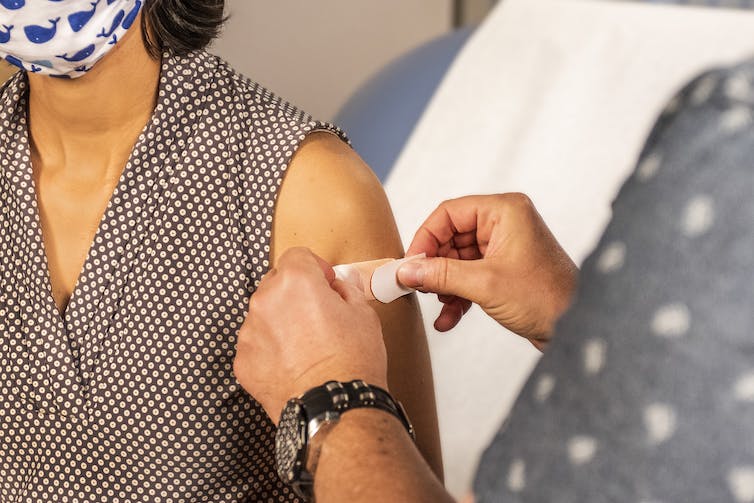当我们遇到并抵抗流感、SARS-CoV-2或RSV等病毒时,我们的身体会发生什么?
概要
流感病毒、SARS-CoV-2病毒和呼吸道合胞病毒等呼吸道病毒可通过感染我们的呼吸系统(包括鼻子、上呼吸道和肺部)而使我们生病。当人们咳嗽、打喷嚏或说话时,它们会通过呼吸道飞沫在人与人之间传播,严重时可能导致死亡。当第一次遇到这些病毒时,人身体中的免疫系统使用多种策略来抵抗病毒感染。
第一道防线:鼻子、上呼吸道和肺部的物理和化学屏障是第一道防线。细胞表面的粘液内层和毛发状结构等屏障共同作用,在病毒深入到呼吸系统之前捕获并清除它们。防御还包括我们的行为,例如咳嗽或打喷嚏。但有时,病毒会设法逃避这些防线并潜入呼吸系统,这会激活先天免疫系统。
巡逻潜在入侵者:人的先天免疫系统在出生时就存在,通过识别外来物质产生“非特异性”免疫力。而先天免疫细胞例如巨噬细胞、中性粒细胞和自然杀伤细胞,像巡逻系统一样寻找任何入侵者,如果识别出任何异物(在本例中为病毒),就会发起攻击响应。
发起特定攻击:当先天免疫反应开始时,适应性免疫系统也被激活。它更具特异性,决定对抗病毒入侵者的正确工具和策略。T细胞和B细胞等特殊细胞是获得性免疫的关键参与者,T细胞(特别是辅助T细胞和细胞毒性T细胞)识别受感染细胞表面的病毒蛋白,B细胞产生抗体,抗体与病毒结合、中和病毒并标记病毒以供其他免疫细胞破坏的蛋白质。
消除威胁:随着免疫反应的进展,先天性免疫系统和适应性免疫系统的共同努力有助于控制病毒。受感染的细胞被清除,病毒被中和并从体内消除。
What happens in our body when we encounter and fight off a virus like the flu, SARS-CoV-2 or RSV?
Respiratory viruses like influenza virus (flu), SARS-CoV-2 (which causes COVID) and respiratory syncytial virus (RSV) can make us sick by infecting our respiratory system, including the nose, upper airways and lungs.
They spread from person to person through respiratory droplets when someone coughs, sneezes, or talks and can cause death in serious cases.
But what happens in our body when we first encounter these viruses? Our immune system uses a number of strategies to fight off viral infections. Let’s look at how it does this.
First line of defence
When we encounter respiratory viruses, the first line of defence is the physical and chemical barriers in our nose, upper airways, and lungs. Barriers like the mucus lining and hair-like structures on the surface of cells, work together to trap and remove viruses before they can reach deeper into our respiratory system.
Our defence also includes our behaviours such as coughing or sneezing. When we blow our nose, the mucus, viruses, and any other pathogens that are caught within it are expelled.
But sometimes, viruses manage to evade these initial barriers and sneak into our respiratory system. This activates the cells of our innate immune system.

Sneezing and blowing our nose can help expel the virus. Shutterstock
Patrolling for potential invaders
While our acquired immune system develops over time, our innate immune system is present at birth. It generates “non-specific” immunity by identifying what’s foreign. The cells of innate immunity act like a patrol system, searching for any invaders. These innate cells patrol almost every part of our body, from our skin to our nose, lungs and even internal organs.
Our respiratory system has different type of innate cells such – as macrophages, neutrophils and natural killer cells – which patrol in our body looking for intruders. If they recognise anything foreign, in this case a virus, they will initiate an attack response.
Each cell type plays a slightly different role. Macrophages, for example, will not only engulf and digest viruses (phagocytosis) but also release a cocktail of different molecules (cytokines) that will warn and recruit other cells to fight against the danger.
In the meantime, natural killer cells, aptly named, attack infected cells, and stop viruses from multiplying and invading our body further.
Natural killer cells also promote inflammation, a crucial part of the immune response. It helps to recruit more immune cells to the site of infection, enhances blood flow, and increases the permeability of blood vessels, allowing immune cells to reach the infected tissues. At this stage, our immune system is fighting a war against viruses and the result can cause inflammation, fevers, coughs and congestion.
Launching a specific attack
As the innate immune response begins, another branch of the immune system called the adaptive immune system is activated.
The adaptive immune system is more specific than the innate immune system, and it decides on the correct tools and strategy to fight off the viral invaders. This system plays a vital role in eliminating the virus and providing long-term protection against future infections.
Specialised cells called T cells and B cells are key players in acquired immunity.
T cells (specifically, helper T cells and cytotoxic T cells) recognise viral proteins on the surface of infected cells:
- 1. helper T cells release molecules that further activate immune cells
- 2. cytotoxic T cells directly kill infected cells with a very great precision, avoiding any healthy cells around.
B cells produce antibodies, which are proteins that can bind to viruses, neutralise them, and mark them for destruction by other immune cells.
B cells are a critical part of memory in our immune system. They will remember what happened and won’t forget for years. When the same virus attacks again, B cells will be ready to fight it off and will neutralise it faster and better.
Thanks to the adaptive immune system, vaccines for respiratory viruses such as the COVID mRNA vaccine keep us protected from being sick or severely ill. However, if the same virus became mutated, our immune system will act as if it was a new virus and will have to fight in a war again.

Vaccines help us generate an immune response to viruses we’re immunised against. CDC/Unsplash
Neutralising the threat
As the immune response progresses, the combined efforts of the innate and adaptive immune systems helps control the virus. Infected cells are cleared, and the virus is neutralised and eliminated from the body.
As the infection subsides, symptoms gradually improve, and we begin to feel better and to recover.
But recovery varies depending on the specific virus and us as individuals. Some respiratory viruses, like rhinoviruses which cause the common cold, may cause relatively mild symptoms and a quick recovery. Others, like the flu, SARS-CoV-2 or severe cases of RSV, may lead to more severe symptoms and a longer recovery time.
Some viruses are very strong and too fast sometimes so that our immune system does not have the time to develop a proper immune response to fight them off.
Source:
The Conversation
Published on 28 July, 2023
声明:本站文章版权归原作者及原出处所有。本文章系本站编辑转载,文章内容为原作者个人观点,登载该文章的目的是为了学习交流和研究,并不代表本站赞同其观点和对其真实性负责,本站只提供参考并不构成任何投资及应用建议。
本站是一个学习交流和研究的平台,网站上部分文章为引用或转载,并不用于任何商业目的。我们已经尽可能的对作者和来源进行了告知,但是能力有限或疏忽,造成漏登或其他问题,请及时联系我们,我们将根据著作权人的要求,立即更正或删除有关内容。本站拥有对本声明的最终解释权。








